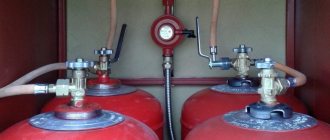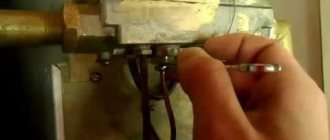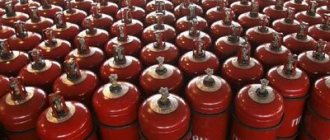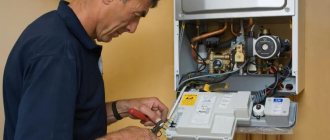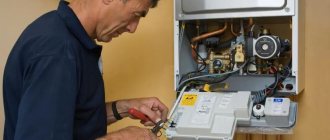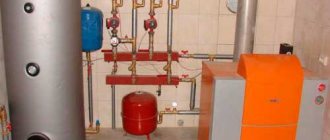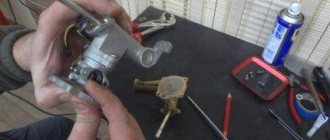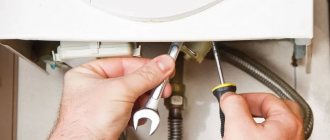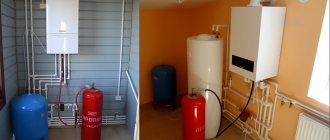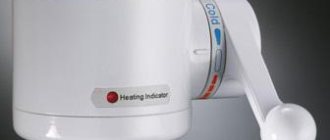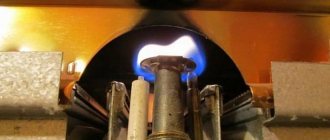Liquefied gas is sold to household consumers in the form of propane and butane, which are obtained after the distillation of natural gas during the distillation of crude oil. It is used not only for cooking and heating residential buildings, but also as a raw material for the chemical industry. Dispensers operating on reduced gas are usually installed in a country house or other premises where there is no main gas pipeline or electricity supply.
How does a liquefied gas dispenser work?
Manufacturers produce several instantaneous and storage gas boilers that can operate on propane. There are universal models of dispensers that can easily operate on liquefied and main gas, after conversion and reconfiguration.
The difference between water heaters using main gas and liquefied gas is in the design of the burner. To understand the difference, you need to imagine exactly how fuel combustion occurs:
- It is not the gas itself that burns, but the gas-air mixture, which is prepared as it passes from the nozzle to the burner nozzle.
- The proportions of methane or propane and oxygen must be strictly observed. A mixture that is rich in air will burn poorly, and a mixture that is poor will smoke.
- The supply speed of propane and methane to the burner is different. Bottled gas is supplied under pressure several times higher than that produced by a household gas pipeline. Accordingly, in order to create normal conditions for fuel combustion, it is necessary to reduce the propane supply rate and stabilize the pressure, which is achieved by changing nozzles and installing a reducer.
If we talk about technical operating conditions, then the possibility of installing an instantaneous or storage water heater using liquefied gas exists in any private home. Unlike connecting to the main gas, there is no need to obtain various permits and prepare a project. The boiler can be connected to one or several cylinders or a gas tank.
Reviews of liquefied gas dispensers show that there is a working nuance that is often not taken into account when connecting. It consists in the following. Propane is pumped into cylinders under pressure, causing it to become a liquid. Gas fills the container approximately ⅔. The liquid evaporates from the surface, after which it enters the reducer and from there it is supplied to the water heater burner.
The difficulty lies in the fact that evaporation occurs with the simultaneous removal of heat. As a result, with high fuel consumption, freezing of the cylinder walls is observed. How to solve the problem is described in the subheading, which describes the nuances of connection.
How to convert a dispenser from methane to propane
Re-equipment is carried out by replacing some components of the water heater and correctly connecting to a gas cylinder installation. Conversion to propane requires:
- change the nozzles on the main burner, depending on the boiler model there are 12-15 of them;
- if a semi-automatic ignition system is used, the jets on the wick are replaced.
In the same way, you can convert a regular gas water heater from natural gas to liquefied gas. The difference is that in universal models, the factory kit already contains nozzles and jets of the required diameter.
The instantaneous water heater is configured to operate on liquefied gas using a mechanical control unit. The body of the water heater is equipped with rotary knobs or levers that regulate the gas pressure supplied to the burner. The optimal mode is considered to be one in which the flames have a bluish-blue color.
What is the propane consumption in a gas water heater?
The exact costs are indicated in the passport for the boiler. For example, Bosh gas flow columns, powered by bottled gas and having a capacity of 25 kW, continuously consume 1 cylinder of fuel per 50 liters for 10 hours.
Costs can be affected by the type of fuel (winter or summer) and its quality. Gas consumption in self-converted water heaters that are not designed to burn propane is usually 5-10% higher. Errors made when connecting equipment are also reflected in costs.
To satisfy the domestic hot water needs of 2-3 people, subject to moderate use of the water heater, the liquefied gas consumption will be one 50 liters. cylinder/month
Advantages and disadvantages of units
Boilers running on liquefied gas are cheaper than appliances using other types of resource. Among the advantages of the equipment are such parameters as:
- complete independence from centralized fuel supplies and regular price increases for utility services;
- high level of efficiency (on average 92-95% and up to 97% for some models);
- quiet burner (for comparison, the burner device of a diesel boiler produces a noise effect of 60-75 dB);
- the equipment does not require labor-intensive and expensive maintenance, replacement of the fuel filter and nozzle, reconfiguration of the burner and cleaning of the heat exchanger;
- complete autonomy of the system and, as a result, the absence of emergency situations;
- unpretentiousness of devices with good reliability;
- the opportunity in the future not to buy a new boiler, but to transfer the existing one to main gas;
- long service life of units (floor-mounted - up to 25 years, wall-mounted - 15-20 years) subject to qualified installation, compliance with operating rules and timely service;
- safety of liquefied gas devices (fuel does not ignite even when the container it contains is heated. Combustion occurs only when the substance and oxygen are mixed, and this happens directly in the burner and only in it).
There are completely energy-independent products on sale that allow you to organize a full-fledged heating system in hard-to-reach conditions, for example, in remote forest areas or high in the mountains.
Of the disadvantages of devices, the following positions are the most significant:
the need for constant high-quality work to connect the boiler to 3-4 propane cylinders using a reducer and ramp; It is not advisable to place containers with liquefied gas near the boiler
It is better to place them in rooms nearby, equipped with a good ventilation system, or take them outside and install them in a special box; care and caution required when connecting the cylinder, since all operations are performed manually and require the use of physical force; subsequent conversion of some boiler models to use regular gas is expensive (replacing the burner costs 30-40% of the total price of the boiler); installation of the unit and connection to gas supply communications must be done by a licensed specialist with experience. The balance of pros and cons must be considered in each individual case and, based on the conclusions drawn, a decision must be made regarding the advisability of purchasing this or that type of equipment
The balance of pros and cons must be considered in each individual case and, based on the conclusions drawn, a decision must be made regarding the advisability of purchasing this or that type of equipment.
Characteristics and distinctive features of geysers
“There is no new custom that is not old,” said Geoffrey Chaucer, the great English poet. And in truth, geysers have long been known to consumers, but this device is not only the past, but also the future. Such devices have many advantages, for example, the use of gas, which is the cheapest source of energy. Since the gas water heater is a flow-through water heater, there is no need to have a separate storage tank. The efficiency of supplying hot water allows you to save a large amount of precious time for your owner. Our catalog of water heaters presents many types and modifications of devices for a wide range of consumers.
Gas water heater device
Externally, the gas heater resembles a metal box, reminiscent of a kitchen cabinet. There are two pipes connected to this design: one for gas, the other for water. Almost all instantaneous gas water heaters have a similar internal structure. The central element is the water heater, which can be made of various materials: cast iron, steel, copper. There are models on sale with a heat exchanger consisting of several sections. The ignition gas burner maintains the flame; after opening the tap, the gas valve opens, supplying gas to the ignition burner. According to the ignition method, geysers can operate mechanically, using electronics or piezo ignition. To remove the burnt gas, a cap is used, which is located above the entire structure.
Operating principle of a geyser
These devices are widely used to provide hot water in both civil and industrial buildings. The principle of operation is as follows: cold water coming from the water supply passes through the pipe and is directed to the heat exchanger of the gas water heater, in which heating occurs thanks to the burner. Oxygen is needed to maintain the flame, so it is equipped with fans or connected to the ventilation system of an apartment or house. Water is heated through a spiral tube located in the heat exchanger. The burnt gas is eliminated thanks to a chimney combined with a gas water heater, and heated water is supplied to the tap.
Advantages of geysers:
- Economical. These devices operate on fuel, which is low in cost, while gas consumption is minimal compared to other types of devices.
- Compactness. Small dimensions allow you to place the gas unit even in the most secluded place. – Convenient operation. Modern models are increasingly adapted to each consumer, which makes working with the device easier.
- Long service life. If you follow the recommendations of professionals, you can use the geyser for a long time without repair or replacement.
- Multifunctionality. Engineers are constantly improving their products, equipping them with a variety of electronic sensors and fuses that allow each user to fully operate the device.
Why is it worth buying geysers from us?
- We have our own warehouse at our disposal, delivering the device to your home without intermediaries.
- We promptly deliver parcels to all regions of Russia.
- We cooperate directly only with official manufacturers who have been producing this equipment for several decades.
- Our consultants have many years of experience and will be able to answer all your questions.
- We provide complete, detailed, and most importantly reliable information about all products.
- Constant promotions and discounts.
- You can make free pickup directly on the day of your order.
- Wide variety of payment options.
Gas water heater safety
The operation of a gas water heater (like any other gas equipment) is associated with the danger of gas leakage or poisoning by combustion products. Fortunately, most water heaters are equipped with elements that significantly increase the safety of their operation:
– Gas control is an automatic device based on a thermal or ionization combustion sensor. When the flame goes out, the automatic system stops the gas supply, preventing its possible leakage. It is especially important to have this option on a water heater if it is installed in a room with sources of open fire - for example, in the kitchen.
– a heating temperature limitation , but if for some reason the limiter does not work, the water in the heat exchanger will boil, which will lead to its rupture and damage to the water heater. The presence of additional protection against overheating prevents such developments.
– Self-diagnosis is implemented on some electronically controlled models. If any element of the water heater breaks down, or if any parameters go beyond the operating limits (lack of draft in the chimney, low water or gas pressure, low oxygen content in the combustion chamber, etc.), the electronics will turn off the water heater and display a message on the display about the error.
Regardless of the number of safety options on the selected model, it should be remembered that no automation cancels safety rules. Correct installation of the water heater, its operation in strict accordance with the attached documentation, knowledge and compliance with the rules for working with gas equipment - this is the key to long and safe operation of the water heater.
How do they work?
The device is connected to a propane-butane cylinder. The process of heating water begins from the moment the tap is opened at the water intake point. Heating occurs when the liquid flows through a metal heat exchanger - copper or steel. The heat exchanger itself is heated by the operating burner. Heated water flows to the water intake, and a hot stream flows from the open tap. How stable the water temperature is depends on the characteristics of the water heater - power and performance.
More details on the page “Can a gas water heater be powered by a gas cylinder?”
Pros and cons of running a boiler using propane cylinders
- The need to control the fullness of cylinders. For normal operation of a gas boiler you need 3-4 gas cylinders. Monitoring exactly when the gas will run out is quite problematic without additional equipment. If you plan to constantly operate the system, it is better to spend money and connect the boiler to several cylinders through a ramp and reducer.
- Gas cost - compared to the main connection, LPG heating costs are slightly higher, but less than when using an electric boiler.
- Features when connecting to a propane tank. According to the PB, you will need to take the containers to another ventilated room or outside, which is not always convenient. It is necessary to separately purchase a device for connecting at least four gas cylinders to the boiler, as well as control and control valves.
- Conversion - not all boilers can be converted to LPG with the same efficiency. Replacing the burner will cost approximately 30-40% of the total cost of the boiler.
- The need to attract qualified specialists. Only a licensed specialist can connect several propane cylinders into a single network, change the burner and make the connection correctly.
Advantages
Pros of propane water heaters:
- efficiency - cheap fuel and low cost of equipment;
- high efficiency value of the heat exchanger - reaches 88%;
- a hydraulic gas burner device is used that regulates the supply of propane - it reacts to changes in pressure;
- you can choose a modification that suits your specific requirements - a wide range of models is offered.
Which model should you choose?
It all depends on the conditions of its use:
- Speaker power. How much domestic hot water do you plan to receive per minute (and room heating)?
- Is main gas connection available?
- How will you ignite the column: automatic, manual or mini-turbine?
- Dimensions of the room where the speaker will be located: a three-dimensional structure is unlikely to fit into small-sized apartments.
- Frequent changes in water supply pressure. Some models require a certain water pressure and turn off when the pressure is low.
Of course, you need to choose from the model range of a manufacturer that has proven itself with quality products (or rely on the recommendations of friends and family).
Connecting equipment to the cylinder
Before you start connecting the equipment yourself, make sure that the model is really suitable.
On a note! There are many manufacturers that produce columns that can operate on “liquid” gas. For example, one of these. Read more about it on the page “Geysers Neva”.
Other brands of acceptable equipment: Vaillant. Bosch (almost all latest models). The instructions for the Bosch speakers indicate that a 50-liter cylinder will be enough for 10 hours of stable operation at a power of 25 kW. A conversion kit for Bosch speakers can be purchased from an authorized service center.
If it is necessary to carry out work on reconfiguring equipment, replacing collector nozzles and assessing the tightness of joints, they must be done strictly according to the rules. The nozzles must be smaller in diameter: as in gas stoves, the pressure produced by liquefied gas reducers is 2–3 times higher than when natural gas is supplied through pipes. At the same time, the calorific value of liquid fuel is 1.5 times greater than that of natural gas.
The equipment must be marked with a refurbishment date - day, month and year. The type of gas suitable for use is also indicated.
The connection diagram of the cylinder to the main valve requires it to have a reducer with pressure stabilization of 300 mm of water. Art. and a minimum steam phase productivity of one cubic meter per hour.
Parameters of the hose connecting gas equipment to the fuel tank:
- 250 Washing machine - minimum length;
- 1.2 Washing machine - the least permissible inner diameter of the tube.
Important! When installing the hose tube, do not bend or twist it under any circumstances. Even if bending is required, use adapters and watch the radius - it cannot be less than 9 Washing machine along the outer arc. And also do not bend the hose earlier than 5 Washing machine from the end of its tips.
Please note that on online forums there is information of the following nature: if you reconfigure the column correctly and carry out the work without flaws, problems with water pressure may arise and the column will not start. Then you will need to additionally install a pressure pump.
When installing a shut-off valve, remember that it must be easy to access so that in the event of an emergency the user can quickly turn it off.
After completing the installation work, check the tightness of the connections and conduct a test run of the equipment.
Sources:
https://o-vannoy.ru/gazovye-kolonki/gazovyj-ballon/ https://cosmo-frost.ru/gazovye-kolonki-i-kotly/ustanovka-gazovye-kolonki-i-kotly/mozhet-li- gazovaya-kolonka-rabotat-ot-gazovogo-ballona/
Are there turbocharged models?
To heat water, you can use a turbocharged water heater. Such devices do not require a traditional vertical chimney; combustion products are discharged through a coaxial pipe led through the wall. It also supplies air to the closed firebox to maintain the combustion process. Turbocharged speakers have disadvantages: you need to make a hole in the pipe, ask the consent of neighbors above to install the equipment, the device is noisy due to the operation of the turbine. Plus, when working on propane-butane, you will also need to place a cylinder in the room. An important advantage of turbocharged versions is their versatility; they can be placed in any room, since a chimney is not needed. The second important advantage is that they do not “eat up” the home air.
Organization of the gas system
To properly organize the gas system, gas consumption is calculated. Gas consumption is calculated based on the heated area. The number of cylinders is calculated from the volume of gas consumed. But no more than 6 pieces. in one system. The cylinder system is connected using a ramp, which ensures a safe and stable supply of gas to the gas boiler.
The cylinder system is located in a metal cabinet at a distance of at least 0.5 m from the house. Ventilation holes are drilled at the top and bottom of the cabinet. The cabinet must be freely accessible. It is recommended to place a cabinet with a balloon system on the north side of the house.
Types and characteristics of liquefied gas
Natural gas was used for heating premises; difficulties with its storage prompted the invention of liquefied gas. It is a mixture of propane and butane. Liquefied gas is more convenient to store and transport.
The advantage of liquefied gas
- The production of a gas mixture is not technically complex or costly.
- The gas mixture is environmentally friendly due to low-contamination waste substances.
Disadvantages of propane-butane mixture
- when filling cylinders at gas stations, there is a possibility of filling them with low-quality gas;
- cylinders are changed manually;
- the liquefied gas mixture is explosive, safety precautions must be observed;
- To ensure that the mixture burns completely, the place where the cylinders are stored is ensured with proper ventilation.
Features of choosing a boiler using bottled gas
Houses are heated by three types of gas cylinders:
- Single-circuit boiler.
- Double-circuit boiler.
- Condensing boiler.
A single-circuit boiler is manufactured with a closed combustion chamber. The boiler flame is enriched with oxygen located inside the room. Waste materials exit through the chimney.
A single-circuit boiler is designed for heating a room. Such boilers are installed if the problem with hot water is solved.
Double-circuit boilers are designed for heating and hot water supply at home. The heater operates due to the operation of 2 burners. They are ignited using an igniter with built-in piezoelectric elements. After the pilot light ignites, a temperature sensor is included in the process, which is activated when a certain temperature is reached and closes the combustion chamber. Waste materials exit through a chimney or ventilation. Double-circuit gas boilers running on bottled gas are a convenient option for solving the problem of heating and supplying hot water.
A condensing boiler provides the home with heat and hot water. Cold water entering the heat exchanger is heated by a burner and hot air. After this procedure, part of the water is used for heating the house, the other part of the water is used for household needs. After completing the full cycle, the water from the radiator returns to the heat exchanger.
The bottled gas condensing boiler is available in two types:
- floor-mounted boiler;
- wall-mounted boiler.
Exhaust gas products exit through the chimney to the outside.
What volume of gas cylinder to choose
Based solely on current propane costs, it will be enough to install one 50 liter cylinder. Even with uneconomical consumption of liquefied gas, the fuel should last for 10-15 days. And this is assuming a large family of 4-5 people. The technical data sheet for water heaters states that a 50 liter gas cylinder is enough for 10-12 hours of continuous operation.
Experts recommend connecting a propane dispenser through a ramp. Thus, it is possible to reduce the load when operating a gas water heater from one to several gas cylinders, evenly distributing fuel consumption and preventing freezing of the walls and reducer. Connection via a ramp allows you to install several smaller containers of 25/40 liters each. Or, as an option, use 50 liter cylinders connected in conjunction with each other. {banner_downtext}
| Weight and internal volume of gas cylinders | ||||
| Volume (l) | 5 | 12 | 27 | 50 |
| Empty cylinder weight (kg) | 4 | 5,5 | 14,5 | 22,0 |
| Weight of propane cylinder (kg) | 6 | 11 | 25,9 | 43,2 |
| Gas mass (kg) | 2 | 5,5 | 11,4 | 21,2 |
| Cylinder height (mm) | 290 | 500 | 600 | 930 |
| Cylinder diameter (mm) | 200 | 230 | 299 | 299 |
| The volume of gas in the cylinder depending on the capacity | ||||
| Cylinder capacity (l) | 5 | 12 | 27 | 50 |
| Gas capacity (m³) | 0,95 | 2,59 | 5,38 | 10,01 |
| Liquid propane volume (l) | 4,3 | 10,2 | 22,9 | 42,5 |
How to connect a column to a gas cylinder
During installation, the peculiarities of propane storage and combustion are taken into account. The dispenser will operate from bottled gas only when the supply pressure is reduced to 0.2-0.3 mBar and the nozzles are replaced. It is important to prevent the cylinders from freezing. To ensure the described conditions, the connection of a liquefied gas water heater is carried out in accordance with the following diagram:
- cylinders are connected via a ramp, several at a time, from 2-4 pcs.;
- To normalize the pressure, an adjustable reducer is installed.
If you connect a gas cylinder to a gas instantaneous or storage water heater according to the scheme described above, replace the jets on the wick and the nozzles on the main burner, adjust the fuel and water supply, you can achieve stable operation of the column after converting to propane.
Options for choosing gas water heaters
An instantaneous gas water heater will provide you with hot water at a minimal price - it is inexpensive, and a liter of hot water will be cheaper than any other option.
A storage gas water heater is indispensable when a short-term water flow rate of more than 20 l/min is needed or when gas pressure is low.
To be sure of the safety of your water heater, choose among models with maximum safety options.
For a family of 2-3 people, a flow-through water heater with a capacity of 10-12 l/min will be sufficient - this is enough to operate the shower and sink simultaneously.
Source
Leading manufacturers of geysers
If we take into account not only the technical capabilities of production sites, advertising campaigns of chambers of commerce, but also the opinions of consumers from all over the world, it becomes possible to form a kind of rating of leading manufacturers whose employment profile is limited to the manufacture, sale and installation of modern-type geysers. They differ according to the following characteristics:
- German geysers Vaillant. A special distinctive feature of this brand’s equipment is reliability, high quality assembly, long service life, and adaptability to Russian technical conditions of use;
- German Bosch equipment distinguishes from a range of analog products a wide range of offers, high reliability of execution, and a high level of product safety;
- Italian manufacturer Ariston has won its place in the top three brands with an affordable price and high quality of the products offered. The unique technology of using durable composite consumables for the production of goods sets them apart from the general mass of modern proposals;
- the domestic representative of geyser manufacturers Niva is distinguished by the low cost of fairly high-quality units of goods, a wide range of offers, versatility, and the availability of repair work;
- Chinese goods produced by Termaxi. The advantage of the products is the presence of a modulation type burner in each product.
How to choose a geyser based on power and other characteristics of modern models
"Neva"
Water heaters "Neva" are products of OJSC Gazapparat. They are simple, reliable, economical and have low fuel consumption. Affordable. You can always find the necessary spare parts.
"Neva" 6011
Propane flow column. Estimated cost - 12,500 rubles. The modification is equipped with an automatic temperature control function with an accuracy of 1°C. There is a digital panel, mechanical buttons. The temperature is shown on the screen. Fault codes are also displayed here - there is self-diagnosis. Reliable protection against emergency situations. Technical features and parameters:
| Capacity, l/min | 11 |
| Nominal thermal performance, kW | 21 |
| Natural gas consumption, m³/h | 2,2 |
| Weight, kg | 10,4 |
| Minimum water pressure, bar | 0,15 |
| Dimensions (HxWxD), mm | 565x290x221 |
- auto ignition;
- open firebox with water cooling;
- no control panel provided;
- productivity - 11 l/min.
"Neva" 4510
Small 17 kW heater. Designed for 2 water intake points. For control - an electronic system. There is auto-ignition and indication. Weighs 10 kg. There is no constant burning pilot light - this is a plus.
| Capacity, l/min | 10 |
| Nominal thermal performance, kW | 17 |
| Natural gas consumption, m³/h | 1,95 |
| Liquefied gas consumption, kg/hour | 0,77 |
| Weight, kg | 10 |
| Minimum water pressure, bar | 0,15 |
| Dimensions (HxWxD), mm | 356x624x186 |
"Neva" 4511
Cost - 9,500 rubles. Wall option. Indicators - inclusion and pressure. Automatic ignition and open firebox. Characteristics:
| Capacity, l/min | 11 |
| Nominal thermal performance, kW | 21 |
| Natural gas consumption, m³/h | 2,2 |
| Liquefied gas consumption, kg/hour | 0,8 |
| Weight, kg | 11 |
| Minimum water pressure, bar | 0,15 |
| Dimensions (HxWxD), mm | 290x565x221 |
Types of fuel for the dispenser
The substances used to heat water are called propane and butane. These are derivatives released during the processing of “black gold” - oil (gasoline, gas). Both pure technical butane and a mixture of butane and propane are used in winter or summer versions.
When compressed, gases turn into a liquid state and occupy less volume. That is why this type of fuel is often called “liquefied”.
When the pressure decreases, the gas turns into a vapor state. Since gas tends to expand at high temperatures, the cylinder is usually filled to 85% of its full volume. If you think that you have not been “refilled” with fuel, this is for your own safety.
Fact! Above the liquid gas there will always be a layer of gas in the vapor state.
